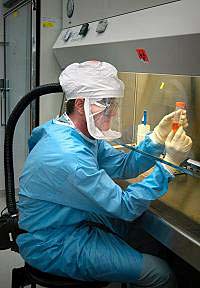1986 UMD Biology Graduate Terrence Tumpey is
Senior Microbiologist at Center for Disease Control and Prevention
The Work is Dangerous--the Precautions Meticulous
Terrence Tumpey, Ph.D., a 1986 UMD biology graduate and senior microbiologist at the Influenza Branch of the Center for Disease Control and Prevention, is at the forefront of the research on avian flu.
"Studying the influenza virus is a challenge," he said. "We're always trying to stay one step ahead. We're amazed at how it can adapt if you give it time." he added.

Tumpey and his colleagues are studying the lethal 1918 virus that killed 50 million worldwide and half a million in the U.S. alone. Their work, as reported in the October, 2005 issue of Science (vol 310, p 77) uses a technique called reverse genetics to re-create a living 1918 virus. First, they gathered viral DNA from the preserved tissues of people who died in 1918 and 1919 -- including a woman whose body was frozen in the Alaskan permafrost.
Tumpey's research has determined that avian flu is genetically similar to the Spanish flu of 1918. The virus began with bird flu genes but then mutated to become infectious to humans. The research team also found that the 1918 flu was a purely avian virus, not a hybrid. It appeared to have passed directly from birds to humans and mutated on its own. Scientists say this is one mode of viral infection and the possible cause of the rapid spread of the 1918 pandemic.
The Spanish flu began with mild outbreaks in the spring of 1918 but then swept the globe by the fall. Nearly half of those who died were young, healthy adults. instead of the usual flu victims, young children and the elderly. Soldiers returning from World War I also brought the virus home with them. Poor hygiene and uninformed medical practice helped spread the pandemic.
Tumpey's tests revealed that 1918 flu had a unique function. It targeted deeper areas of the lungs than standard viruses. It affected the delicate tissues where oxygen and carbon dioxide are exchanged, creating inflammation deep in the lungs and blocking the airways.
His work is extremely dangerous so the precautions are meticulous. All viruses are handled inside a biosafety cabinet. Researchers wear a half-body suit with a respirator and all the air they breathe is filtered. Rigorous security requirements include fingerprinting pads and retina scanning, and guarantee the virus doesn't fall into the wrong hands.

Three worldwide outbreaks of flu occurred in 1918, 1957 and 1968. The 1957 pandemic killed about 70,000 Americans and the 1968 "Hong Kong flu'' killed about 34,000. The milder pandemic flu bugs of 1957 and 1968 also had bird flu genes. But they picked up the ability to spread in humans by swapping genes with a human flu virus. While all three flus may have been caused at least partially by viruses from animals, the 1918 flu, by far the most deadly, may have started when a bird virus acquired a genetic changes allowing for human-to-human spread. The presence of genes from the human virus gave the human immune system some ability to recognize the flu and fight it off.
Researchers downplayed the risk of bringing back to life a virus that killed millions of people 87 years ago. People who survived the initial 1918 outbreak gained immunity to the virus, and milder versions of the Spanish flu have been circulating among people for decades.
"By identifying the characteristics that made the 1918 influenza virus so harmful, we have information that will help us develop new vaccines and treatments," said Tumpey. "Influenza viruses are constantly evolving, and that means our science needs to evolve if we want to protect as many people as possible from pandemic influenza."
After graduating from UMD, Tumpey worked for five years as a laboratory technician at the Department of Ophthalmology, University of Illinois, Chicago. There he started working on herpes simplex type one (HSV-1) ocular disease and got interested in immunology, particularly immune responses associated with the eye. He was accepted in the Ph.D. program at the University of South Alabama (USA) where he continued his work with HSV-1 induced ocular disease. He received his doctorate in basic medical sciences at the USA College of Medicine in 1997. During graduate school he became interested in influenza and applied for a ASM postdoctoral fellowship. He received a two-year fellowship to work at the Influenza Branch, CDC and continues working there today as senior microbiologist.
Tumpey said he still occasionally reads his undergraduate UMD textbooks, such as Dr David.Schimpf's Ecology and Dr. A. R. Klemer's Limnology textbooks. He credits his academic advisor at UMD, Dr. Schimpf, for making sure Tumpey signed up for the right classes and for finding work study jobs that increased his fascination with science.
Choose appearance:
[ Desktop
| Mobile friendly ]